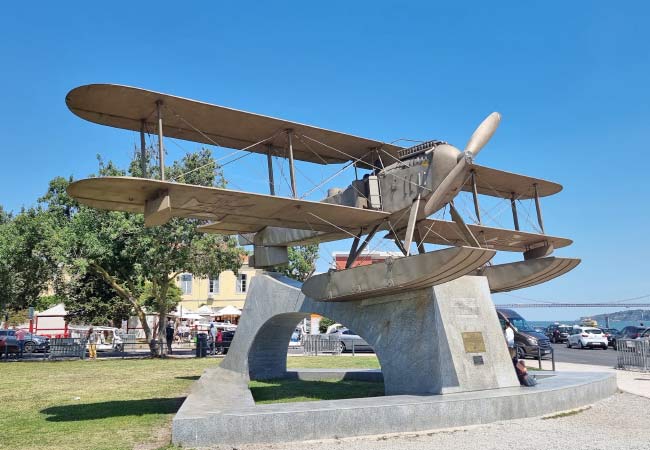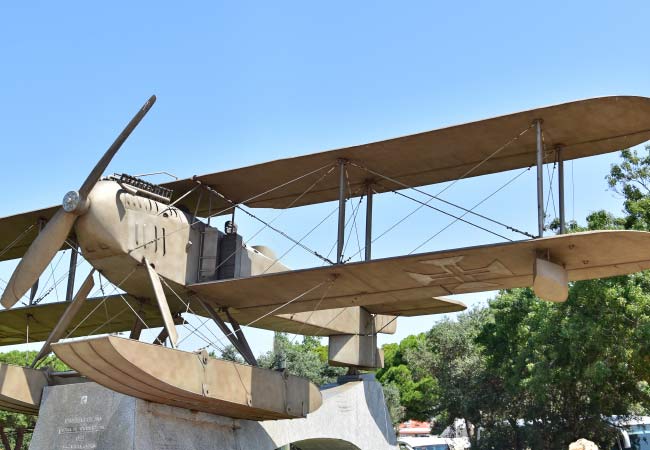LisbonLisboaPortugal.com
The best independent guide to Lisbon
LisbonLisboaPortugal.com
The best independent guide to Lisbon
The Gago Coutinho Fairey-Seaplane Monument in Belém, Lisbon
Gago Coutinho was an early Portuguese aviation pioneer who is commemorated in Lisbon by a monument of his biplane, the Lusitânia. Gago Coutinho and Sacadura Cabral were the first pilots to fly across the South Atlantic Ocean.
Their flight of 8,400 km departed from Lisbon on 24 March 1922 and arrived in Rio de Janeiro 79 days later, on 6 June 1922.
The seaplane monument in Belém commemorates this perilous voyage and is an exact replica of their Fairey IIIB seaplane.
The monument of the Lusitânia biplane is located in the Belém district, close to the Torre de Belém. It signifies the spot from which the seaplane took off.

The monument of the Lusitânia plane
Gago Coutinho's Atlantic Flight from Lisbon to Rio
The Lusitânia Fairey seaplane used by Coutinho and Cabral for their transatlantic flight did not have the fuel capacity to make the entire trip unaided, so various stops were required along the route.
The aviators were shadowed by a support ship called the República. On the journey down the Brazilian coast, a heavy rainstorm caused the aircraft’s engine to fail, and they were forced to ditch into the Atlantic Ocean.
Realising that something was wrong, the support ship República sent out a distress signal, asking other ships in the area to look out for the seaplane. After a worrying period in the water, the pilots were found by a British freighter.
The rescued Coutinho and Cabral were distraught as they had lost their plane so close to their final destination after an incredibly long time flying. Following a heated negotiation, Coutinho and Cabral managed to secure a new aircraft loaned by the British, which they used to complete their journey.
This historic flight was achieved using the precision sextant for navigation, demonstrating its effectiveness and revolutionising aerial navigation.

The monument of the Gago Coutinho and Sacadura Cabral Plane in Lisbon
Gago Coutinho Other Contributions to Early Aviation
Gago Coutinho's contributions to aviation were not limited just to long-distance flying; he also invented a sextant that incorporated two spirit levels, which provided an artificial horizon. This adaptation of the traditional marine sextant allowed navigation without visual reference to the real horizon, which was particularly useful when flying through heavy fog or cloud.
Discover more of Lisbon with our most popular guides
If you've found our content valuable, we'd welcome your support.
The digital publishing landscape has evolved significantly. As a small independent publisher, we face growing challenges. Search engines increasingly favour paid content over organic results, while AI-generated content often reproduces original work without attribution.
To support our work, please consider bookmarking this page (press Ctrl + D) for quick access. If you find an article helpful, we'd be grateful if you'd share it with friends on social media.
For specific questions, please see our Reddit community at r/LisbonPortugalTravel.
Should you notice any outdated or incorrect information, please contact us at [email protected]
Thank you for helping us continue to provide valuable content in an increasingly challenging digital environment.
A complete list of all of our Lisbon articles
If you've found our content valuable, we'd welcome your support.
The digital publishing landscape has evolved significantly. As a small independent publisher, we face growing challenges. Search engines increasingly favour paid content over organic results, while AI-generated content often reproduces original work without attribution.
To support our work, please consider bookmarking this page (press Ctrl + D) for quick access. If you find an article helpful, we'd be grateful if you'd share it with friends on social media.
For specific questions, please see our Reddit community at r/LisbonPortugalTravel.
Should you notice any outdated or incorrect information, please contact us at [email protected]
Thank you for helping us continue to provide valuable content in an increasingly challenging digital environment.































